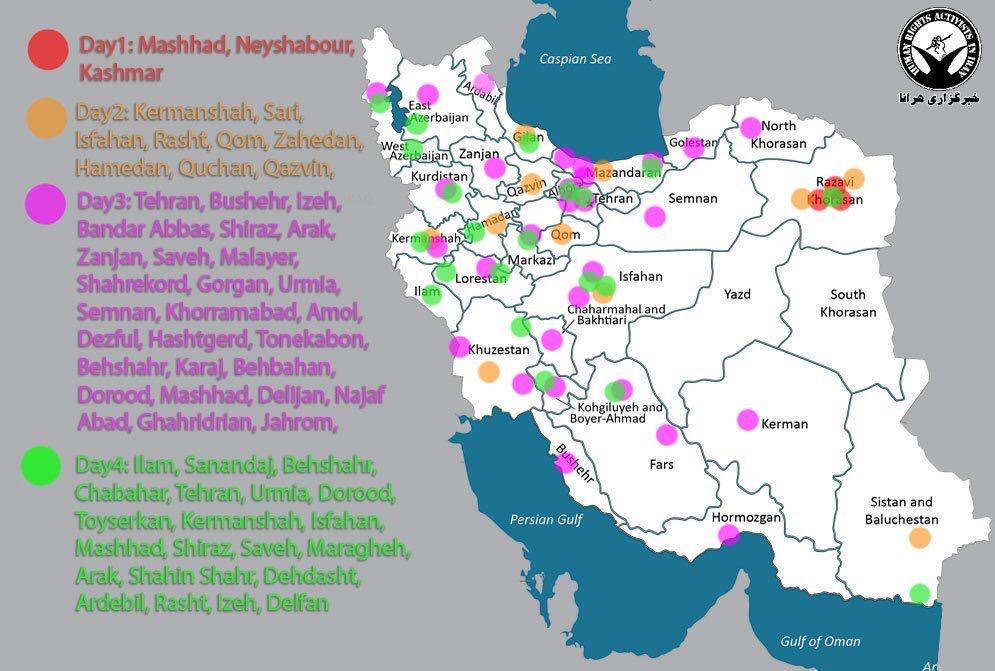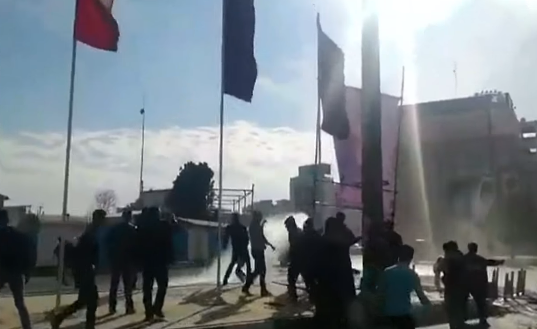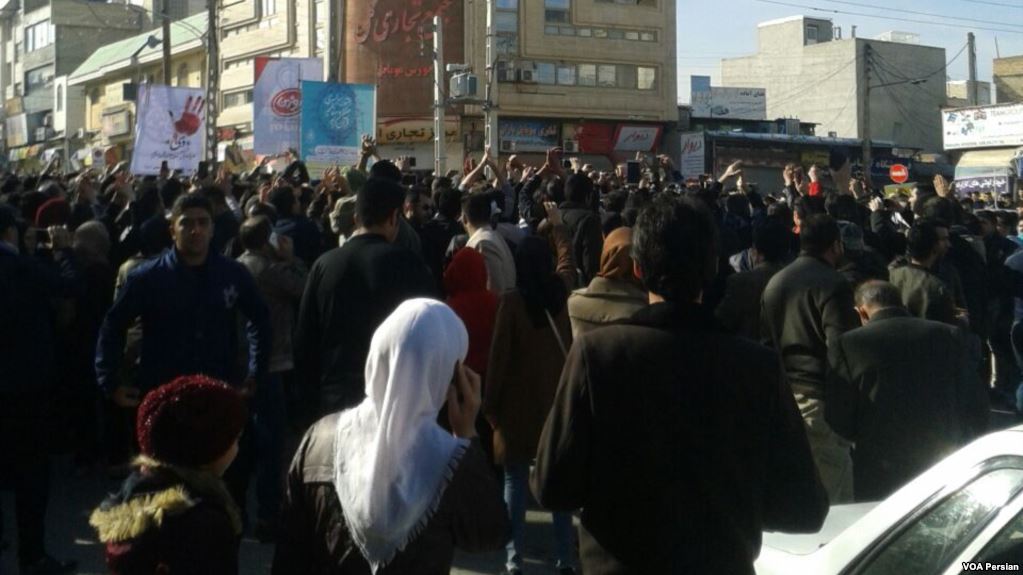For the past four days Iran has seen the most widespread protests since the 1979 Revolution. While it is still smaller in size than the 2009 Green movement, it has spread far beyond the mainly urban areas of the big cities to which that movement was mainly confined. This is a sea-change and it has shaken the regime to its foundations.
So far it appears that 52 cities in 27 provinces have seen protests since people first took to the streets of Mashhad on 28 December. The first protests took place in Mashad and were initially aimed at President Hassan Rouhani. In fact, it initially received the backing of the hard-line reactionary, Friday Prayer Imam of Mashad and custodian of the $15+ billion Imam Reza Endowment, Ahmad Alamolhoda.
However, the slogans quickly turned against the whole clerical establishment. Mashad, Iran’s second largest city, has always been seen as a conservative and religious city in which the hard-line political factions enjoyed high support. But in the past years the mood has changed in the city. In fact, the defining feature of all of these protests is the fact that they have taken place in areas and among layers where the regime has traditionally enjoyed higher support.
On the 29th, in the holy city of Qom, home to the highest clerical institutions, thousands of people took to the streets with chants such as “Death to Hezbollah” and “Seyad Ali [Khamenei] leave, let go of power” and “Death to the Islamic Republic”. At one point the picture of Che Guevara was also seen on the demo.
#Update7 :protesters attacked the governor office of #Hamedan, chanting: “ Death to the Islamic Republic”, “We don’t want Islamic Republic”.#Qom chanting “Death to the Islamic Republic “, “Death to Hezbollah”, we don’t want an Islamic Republic”#Iranprotests #RegimeChange pic.twitter.com/GlsovMmygg
— Raman Ghavami (@Raman_Ghavami) December 29, 2017
In the northern city of Rasht the crowds were chanting “Noble army, help the people”. In Hashtgard a large crowd were chanting “The only aim is the regime, this is [our] last word”.
Day 4. Protesters in Rasht are asking the army to help them: Noble Army Help Your People pic.twitter.com/OKnnd4EDT5
— IranWire (@IranWireEnglish) January 1, 2018
Other slogans were against Iran’s interventions in the Syrian Civil War, saying “leave Syria, think about us!”
Yesterday the first small protests also erupted in Tehran, mainly initiated by youth around Tehran University. An eyewitness report in IranWire explained: “The slogans were centered around the economy. Unemployment, poverty and destitution have made people desperate. Then the slogans turned to political and civil rights including the right to be free ‒ individual freedom, freedom in thought and freedom for groups of people. University students joined the people because students are part of the people.”
The slogans raised at the demo in Tehran included “Death to the Dictator," “People are paupers while the mullahs live like a god” and “Independence, Freedom, Iranian Republic. [As opposed to Islamic Republic, ed.]”
NOW in front of university of #Tehran, security forces are beating a student. Iran's Islamic regime media always show how Palestinians are being beaten by Israeli police, but they don't show you how they brutally hit innocent Iranian university students. pic.twitter.com/U59Ub5VYVK
— Babak Taghvaee (@BabakTaghvaee) December 30, 2017
Other slogans included “We die, we die but we will get Iran back” and “Reformists and Principlists, the story is ending”, “Bread, Jobs, Freedom”, “Students and workers unite”. The police cracked down hard on the protest in Tehran and there are reports that at least 200 people were arrested, but eventually the protests spilled over into the streets where at one point a police van was attacked and the detained protesters inside were reportedly freed. Today the protests in Tehran are set to continue.
At the same time several banks, in particular connected to the Revolutionary Guards, have been attacked, prompting the police to deploy extra security to banks throughout the country.
Also in the city of Izeh violent clashes erupted between protesters, who at a point were reported to have expelled security forces altogether. Two people were killed in these clashes. State TV has reported 10 dead so far as a result of the crackdown. Nevertheless, the scale of the protests has generally forced the state to adopt a careful approach in order to avoid provoking an even bigger movement.
But it appears that the protests are set to continue regardless. While the protests in Tehran were small initially, there are signs that they might be gathering pace and could lead to larger manifestations today where new cities are also expected to join in.
The rapid spread of the movement has stunned the regime, which has been struggling to come up with an adequate response. After several days of silence, President Hassan Rouhani appeared on the television yesterday. He acknowledged that “people have the right to criticise”, but at the same time threatened that the regime was ready to crackdown in case of “violence and destroying of public properties”.
Meanwhile, hundreds of peaceful protesters at Tehran University were being beaten up and arrested en masse, while protesters were being killed in other parts of the country. Other liberal “Reformists”, such as Masoumeh Ebtekar have been outright calling for a crackdown to rein in the masses. These liberals will defend democratic rights ‒ but only to the extent that these rights are not actually used to formulate the real aspirations of the masses.
Rouhani came to power five years ago with promises of change. Millions of people from all layers of society rallied around his promises to end the securitised atmosphere, freeing political prisoners, increasing democratic rights, ending Iran’s isolation, and raising living standards. His promise of “not just turning the wheels of centrifuges, but also the livelihood of the people” resonated with millions of workers and poor. But four years later, ordinary people are still struggling. Unemployment has been steadily rising and although inflation in general has been brought under control, the cost of living has been steadily rising. Furthermore, the Rouhani administration is planning to cut subsidies on basic goods as well as cash benefits for the poorest even further.
 Infographic of Iranian protests 2017 / Image: HRANA
Infographic of Iranian protests 2017 / Image: HRANA
What we are witnessing now is a rebellion of these layers: the poor, the dispossessed, the lower middle classes and sections of the working class. Coming from conservative areas, these layers have held their heads low for decades, accepting their lot. In fact, many of the people on the streets are from the same layers the regime has often leaned on. But that is clearly over.
Of course, at this stage, the slogans are very confused, ranging from economic demands and "death to the dictator" to praising Reza Khan. All of this reflects a deep-seated anger against the whole rotten Islamic Republic. People are hungry and tired of unemployment, inflation and corruption. The pious and clean cover that the clergy traditionally hides behind has been tarnished by decades of rotten and corrupt rule.
 Iran protests 2017 / Image: fair use
Iran protests 2017 / Image: fair use
Meanwhile, Western regimes and the Saudis, as well as Israel, have lined up in trying to gain from this movement. Donald Trump has been tweeting his support for the “Iranian people”. Clearly Trump, Saudi Arabia and Israel are following a regime-change tactic with regards to Iran. But the Iranian people have not forgotten the crimes of western imperialism against them, the latest one being the brutal economic war the US has been waging on the Iranian masses.
It is not clear what will happen after today. It is possible that the movement could temporarily die down. But one thing is clear: this is the beginning of a process of the reawakening of the Iranian revolutionary masses. A new layer of the masses has entered the stage and the crisis of the regime is deepening. These are the first tremors of great historic events that will send shock waves throughout the whole region and radically change the balance of class forces.

